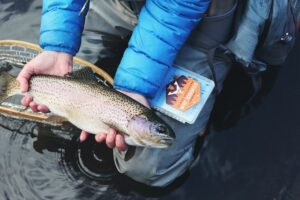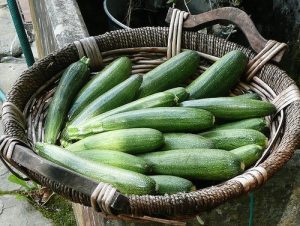The following post is from Katie of Kitchen Stewardship:
Table of Contents
Silicone Bakeware, Silicone Baking Sheets, Silicone Cupcake Liners, etc…
With holiday baking coming up and gift season to boot, I’ve been thinking again about the safety of silicone bakeware. There are several unique kitchen items made for the ease of the people – a large portion of them are fashioned out of silicone. Silicone pans, silicone baking mats, silicone cupcake liner, and silicone cooking utensils are not only a huge trend in the common culture but also touted as a way to “bake green” since you can avoid throwing away aluminum foil or parchment paper if you use and reuse silicone baking mats. They make great gifts since they’re generally both cute and affordable. But is silicone really a safe choice for your health? If you’re in doubt make sure to check the custom food label first.
I’ve been using the baking mats for years under the pretense that silicone is safe, especially compared to the hazards of aluminum and the many safety issues surrounding Teflon.
It seems that a few times a year, I’m asked to explain my rationale for choosing silicone bakeware, and since I can never remember the answer, it’s time to officially revisit that issue: Is silicone bakeware safe? Can it silicone leach into the food or does silicone off-gas into the air?
What is the Composition of Silicone
Silicone is a synthetic (man-made) material created by bonding silicon with oxygen. I think I often type “silicon baking mats” but that’s wrong – silicone baking mats is the material in the bakeware. Silicon is right on the periodic table, a natural element that is in sand and makes up 28% of the earth’s crust. However, I don’t eat on the earth’s crust. “Is a natural substance” can’t be the end of one’s material safety research.
Does Silicone Interact with Food
Silicone is FDA approved as a food-safe substance. (Note: that sentence means very little since the FDA approves a whole bunch of things for human consumption that I don’t trust, like hydrogenated oils, for example.) Almost all the sources I’ve found state that silicone is inert doesn’t react with food or liquids and doesn’t off-gas chemical fumes. Those that stated otherwise were usually single people in a forum or comments railing about silicone being toxic.
Sources that claim “inert” and seem very genuine include Dr. Weil, Scientific American, and the research at Green Living Tips. Sources that claim “silicone off-gasses” include the husband of one of my own readers, a material science engineer, who “will not touch the stuff.”
However, there haven’t actually been studies testing silicone’s reactions with food under heat. The “nonreactive” claim is just based on the fact that silicon (the element) is “inert.” Again, let’s be serious: just because something in nature is fairly stable doesn’t mean I’ll necessarily cook and eat on it.
Note: there is a discrepancy between food-grade silicone and industrial-grade silicone, just something to take note of when doing research on the safety of silicone in general.

Concerns About the Dangers of Silicone Bakeware
With all of that said, here are some things to keep in mind:
- Lower quality silicone coatings contain fillers that may be hazardous. Most sites say that if any white shows through when you twist your silicone bakeware, there are probably fillers. (Going to the kitchen to twist some silicone, excuse me a moment…)
- The oils in silicone, which are very powerful and toxic, may “migrate” from the material, but I can’t find any real data.
- Some sources offer concerns about bright colors and leaching.
- Some (many?) have concerns about odors during use, but that may be related to the fillers, and not the silicone. I do notice an odor or smoking every so often, especially when oil hits the surface (like when roasting pumpkin seeds tossed in EVOO).
- Many silicone baking mats are actually made of fiberglass covered on both sides with silicone, so unless you want to risk fiberglass in your food, don’t cut on the mats!
- It’s reasonably new, so long-term studies haven’t been performed on cookware that has been exposed to high temperatures over very long periods.
I take three issues into account when making purchases for the kitchen: Is it safe for my family? Is it safe for the planet? Does it make the act of making food easier or tastier?
Is Silicone Bakeware Safe?
Just because there aren’t many studies done on food safety and silicone that show that it is not safe most certainly doesn’t mean it is safe. All over the Internet, people are basically saying, “I can’t find anything dangerous about silicone, so I assume it’s a safe material.” That’s basically what I’ve said over the years, and now I’ve just contributed another article to the vastness of the Internet that says little to nothing about the safety of silicone. Drat.
The bottom line on safety is:
- Check your manufacturer for other materials possible contaminating your silicone bakeware.
- Treat it well – no cutting on those baking mats!
- If you want to be very conservative, skip the silicone and stick with glass, cast iron, or stainless steel for cooking and baking and unbleached parchment paper if you need something flexible.
Can you Microwave Silicone?
According to the product manufacturers, silicone is safe for use in the microwave, oven, and freezer.
Yes, I do use it in the microwave and given the choice, would choose it over plastic any day.
Is Silicone Bakeware good for the environment?
Some sources say silicone can be recycled, which is great. It doesn’t take more energy to create than glass or mining metal for pots and pans, and it is not toxic to aquatic or soil organisms.
So for the earth, silicone bakeware is a fine choice compared to just about anything else out there, and better than Teflon, which contains chemicals that won’t break down at all.
Does Silicone Cooking Product Make Cooking Easier or Faster?
Other than when I get them all stained up, I love my baking mats. They’re awesome for homemade crackers and cookies especially. I also swear by my silicone “spoonula” for scrambling eggs in the pan and other stovetop cooking.
However, many people don’t like the way silicone pans, muffin cups, and loaf pans bake unevenly and don’t properly brown the food. I found the muffin tin to be a beast to clean, much worse than its metal counterpart. I gave mine away after one use and went back to paper liners. The “nonstick” claim leaves a lot to be desired on the three-dimensional products, but the mats are still my friend…unless I decide they might be toxic. Sigh.
Do you use silicone bakeware? Why or why not?
| Katie Kimball has been “green” since 5th grade when she read 50 Things Kids Can Do to Save the Earth. She remains slightly disappointed that she didn’t actually save the whole thing back then, but now that she has 3 kiddos counting on her, she keeps plugging away hopefully. Katie blogs at Kitchen Stewardship about real food and natural living and is the author of Healthy Snacks to Go and other eBooks, available for Kindle. | |



